Abstract
Some believe that provision of private property rights in wildlife on private land provides a powerful economic incentive for nature conservation because it enables property owners to market such wildlife or its attributes. If such marketing is profitable, private landholders will conserve the wildlife concerned and its required habitat. But land is not always most profitably used for exploitation of wildlife, and many economic values of wildlife (such as non-use economic values) cannot be marketed. The mobility of some wildlife adds to the limitations of the private-property approach. While some species may be conserved by this approach, it is suboptimal as a single policy approach to nature conservation. Nevertheless, it is being experimented with, in the Northern Territory of Australia where landholders had a possibility of harvesting on their properties a quota of eggs and chicks of red-tailed black cockatoos for commercial sale. This scheme was expected to provide an incentive to private landholders to retain hollow trees essential for the nesting of these birds but failed. This case and others are analysed. Despite private-property failures, the long-term survival of some wildlife species depends on their ability to use private lands without severe harassment, either for their migration or to supplement their available resources, for example, the Asian elephant. Nature conservation on private land is often a useful, if not essential, supplement to conservation on public lands. Community and public incentives for such conservation are outlined.
Similar content being viewed by others
References
Anderson, T.L.: 1991, ‘The Market Process and Environmental Amenities,’ in J. Bennett and W. Block (eds.), Reconciling Environment and the Environment, West Perth, Western Australia: Australian Institute of Public Policy, pp. 133–173.
Australian Petlinks Classified ads, http://www.petlink.com.au/Birds/Advertising_Board/index.html Accessed 17.09.04.
Bandara, R. and Tisdell, C.: 2003, ‘Use and Non-Use Values of Wild Asian Elephants,’ Sri Lanka Economic Journal 4(2), 3–20.
Bandara, R. and Tisdell, C.A.: 2004, ‘The Net Benefit of Saving the Asian Elephant: A Policy and Contingent Valuation Study,’ Ecological Economics 48, 93–107.
Bandara, R. and Tisdell, C.A.: 2002, ‘Asian Elephants as Agricultural Pests: Economics of Control and Compensation in Sri Lanka,’ Natural Resources Journal 42, 491–519.
Benson, D.E., Shelton, R. and Steinbach, D.W.: 1999, Wildlife Stewardship and Recreation on Private Lands, Texas A&M University Press, College Station, Texas.
Bishop, R.C.: 1987, ‘Economic Values Defined,’ in D.J. Decker and G.R. Goff (eds.), Valuing Wildlife: Economic and Social Perspectives, Westview Press, Boulder, Colorado, pp. 24–33.
Bishop, R.C.: 1981, ‘Economic Considerations Affecting Land-Owner Behaviour,’ in R. Dumke, G.V. Burger and J.R. March (eds.), Wildlife Management on Private Lands, Proceedings of a Symposium: Wildlife Management on Private Lands, 3–6 May 1981, Milwaukee Wisconsin, Printed by La Crosse Printing Co., La Crosse, Wisconsin, 54601, pp. 73–86.
Bishop, R.C.: 1979, ‘Endangered Species, Irreversibility and Uncertainty: A Reply,’ American Journal of Agricultural Economics 61(2), 377–379.
Bishop, R.C.: 1978, ‘Endangered Species and Uncertainty: The Economics of a Safe Minimum Standard,’ American Journal of Agricultural Economics 60(1), 10–18.
Brubaker, E.: 1997, ‘Beyond Quotas: Private Property Solutions to Overfishing,’ in R. Arnason, E. Brubaker, M. De Alessi, K. Erikson, P. Macgillivray, T. McClurg, B. Runolfsson, P. Sprout and M. Walker (eds.), Fish or Cut Bait: The Case for Individual Transferable Quotas in the Salmon Fishery of British Columbia, Fraser Institute, Vancouver, pp. 151–178.
Burger, G.V.: 1973, Practical Wildlife Management, Winchester Press, New York.
Child, B.: 1996, ‘The Practice and Principles of Community-Based Wildlife Management in Zimbabwe: The CAMPFIRE Programme,’ Biodiversity and Conservation 5, 369–398.
Ciriacy-Wantrup, S.V.: 1968, Resource Conservation: Economics and Policies, 3rd ed., Division of Agricultural Science, Berkeley, CA.
Clark, C.: 1976, Mathematical Bioeconomics: The Optimal Management of Renewable Resources, John Wiley, New York.
Clark, C.: 1973, ‘Profit Maximisation and the Extinction of Animal Species,’ Journal of Political Economy 81, 950–961.
Crosthwaite, J.: 1995, ‘A Review of Potential Financial Incentives to Achieve Nature Conservation Goals on Private and Leasehold Land,’ A. in Bennett, G. Backhouse and T. Clark (eds.), People and Nature Conservation: Perspectives on Private Land Use and Endangered Species Recovery, The Royal Zoological Society of New South Wales, Mosman, NSW, pp. 191–200.
Freese, C.H. and Trauger, D.I.: 2000, ‘Wildlife Markets and Biodiversity Conservation in North America,’ Wildlife Society Bulletin 28(1), 42–51.
Guynn Jr., D.C.: 1997, ‘Ecosystem Management and Wildlife Management Compatible or Conflicting?’ Proceedings Eastern Wildlife Management Conference 7, 7–11.
Lohr, C., Ballard, W.B. and Beth, A.: 1996, ‘Attitudes Toward Gray Wolf Reintroduction to New Brunswick,’ Wildlife Society Bulletin 24, 414–420.
Parks and Wildlife Commission of the Northern Territory: (no date), A Strategy for Conservation through the Sustainable Use of Wildlife in the Northern Territory of Australia, Palmerston, NT.
Parks and Wildlife Commission of the Northern Territory: 1996, A Management Programme for Crocodylus porosus and Crocodylus johnstoni in the Northern Territory of Australia, Palmerston, NT.
Parks and Wildlife Commission of the Northern Territory: 1997, A Management Programme for the Red-Tailed Black Cockatoo Calyptorhynchus banksii in the Northern Territory of Australia, Palmerston, NT.
Seasholes, B.: 2002, ‘Private conservation of wildlife in Africa,’ Property Rights Foundation of America Inc. http://prfamerica.org/PrivateConservationOfWildlifeInAfrica.html
Smith, R.J.: 1981, ‘Resolving the Tragedy of the Commons by Creating Private Property Rights in Wildlife,’ CATO Journal 1, 438–468.
Tisdell, C.A. and Wilson, C.: 2004, ‘The Public’s Knowledge of and Support for Conservation of Australia’s Tree-Kangaroos and Other Animals,’ Biodiversity and Conservation (in press).
Tisdell, C.A. and Zhu, C.: 1998, ‘Protected Areas, Agricultural Pests and Economic Damage: Conflicts with Elephants and Pests in Yunnan,’ The Environmentalist 18, 109–118.
Author information
Authors and Affiliations
Corresponding author
Rights and permissions
About this article
Cite this article
Tisdell, C.A. Economic Incentives to Conserve Wildlife on Private Lands: Analysis and Policy. Environmentalist 24, 153–163 (2004). https://doi.org/10.1007/s10669-005-6049-9
Issue Date:
DOI: https://doi.org/10.1007/s10669-005-6049-9




